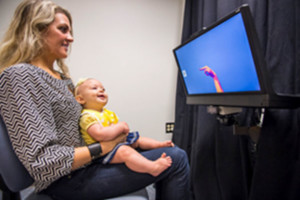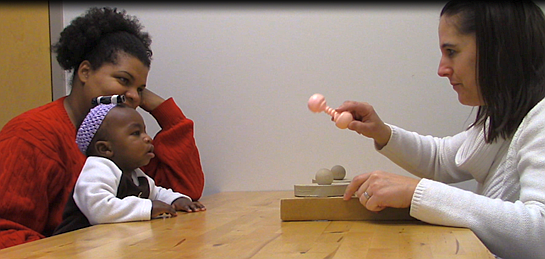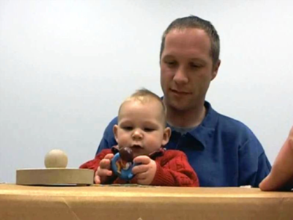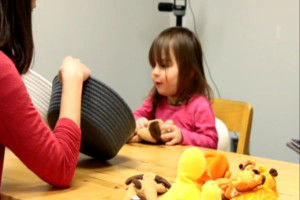Cognitive Neuroscience Inspires Exhibits
WonderLab has worked for more than twenty years to ensure that science education is both accessible and fun. The Developmental Cognitive Neuroscience Lab, (DCN Lab) has been researching the ways that infants and toddlers learn about and experience the world since 2007.

Directed by Dr. Bennett Bertenthal, the DCN Lab’s mission is to study the minds of young children in order to better understand their motivations and actions. At the lab, students and faculty conduct research on cognitive development in children. Using a variety of non-invasive and participatory games, tests, and eye-tracking studies, scientists get glimpses into the complex minds of infants and toddlers.
“I’m a strong proponent of informal education and I’ve always enjoyed science and children’s museums.” said Bertenthal. “For many years I’ve thought about helping to develop new exhibits at children’s museums, but never had the opportunity until now.”
The DCN Lab works to understand children’s motivations and actions through two main types of activities. The first type of activity utilizes eye-tracking and, at times, various mental games on a screen to determine where children look while different variables are in play.
These studies are revealing because humans are a primarily visual species. Determining the trajectory of someone’s gaze imparts a great deal of insight into that person’s thought processes and plans.
According to Eugene Kim, a PhD student with the DCN Lab, this information provides a valuable tool to understand the developing mind. Kim develops 3D-printing puzzle boxes to study nonverbal problem-solving skills in toddlers. After printing the pieces to a puzzle box, Kim puts them together with a small reward inside. These boxes are then provided to toddlers without instructions, and Kim watches to see how they go about the process of learning to open the box by manipulating various buttons, latches, and other mechanisms in order to get to the candy or small toy within.
Kim is also one of the individuals who studies eye-tracking using software built to see where an individual’s eyes are looking. Some of the results show that younger infants most often watch the eyes of adults. When infants get a bit older and begin using their hands more, they begin watching adults’ hands. Once a child starts to acquire language, they begin watching the mouths of adults.
Kim has found that parents particularly enjoy viewing the recordings of their children’s eye tracking data. These visualizations show how their children’s eyes move during the experiments.
“This is a rare opportunity for parents – to be able to see through their child’s eyes quite literally,” said Kim. “It is generally an exciting and novel experience for anyone to be able to see the world as someone else sees it, moment by moment.”
Another method of research happens through games and tests. These experiments look at three forms of executive functioning, also known as the self-regulation of attention and the cognitive processes that underlie an infant’s ability to plan and complete a goal or task.
Level one, behavioral inhibition, is the ability to inhibit instinctual responses in order to make targeted responses. Level two, working memory, is the act of retaining information over a short period of time. Level three, executive attention, is the influence of endogenous factors on attention processes. At the DNC Lab all three executive functioning levels are tested to examine trends in toddler brain development.
Aditi Deodhar, another PhD student in the DCN Lab works with testing and games. “The kids play games that teach them about science and we gather the data,” said Deodhar. This mingling between play and education runs parallel to WonderLab’s mission, and Deodhar has long been a fan of this mission.
“I volunteered [at WonderLab] for years. I enjoyed working with kids and seeing them interact with the exhibits…,” said Deodhar. “I actually helped put together the red push pins in the pin screen exhibits and helped volunteer when WonderLab was on the Square. And WonderLab definitely helped pique my interest in how kids learn.”
WonderLab is hoping to inspire more individuals like Aditi Deodhar. In 2017, WonderLab piloted a new program, Science Sprouts, for children ages birth through three. During the program, educators use live music, body movement, and hands-on activities to teach them scientific principles and encourage inquisitive thinking at a young age. This program grew steadily in popularity eventually moving from once a week to three times a week.
“Science Sprouts sells out almost every time,” said Sarah Ericson, gallery operations assistant director at WonderLab who often works at visitor services. “The class fosters a community and parents get to engage with the children as they’re learning.”
These young scientists will soon have a dedicated space within the museum, Science Sprouts Place, scheduled to open October 2019. Inspiration for these exhibits comes directly from the collaboration between the museum and the DCN Lab.
WonderLab used results from the Lab’s research to help direct and refine the hands-on activities that will be housed in Science Sprouts Place, As a result the scientific principles behind each exhibit are well-defined, educational, and most importantly, fun.
Emmy Brockman, education director at WonderLab, specializes in early childhood education. She stands at the forefront of the efforts behind Science Sprouts Place and is the primary educator for Science Sprouts.
“I want our early-childhood education to be informed by the best thinking out there in child development,” Brockman said. “We have that with the DCN Lab.”
Kim also has high hopes for the collaboration, stating that he wanted it to become a more permanent relationship.
“For WonderLab, attending parents can have an opportunity to see first-hand how their tax dollars are being used to fund cutting-edge scientific research being conducted in the name of advancing our understanding of infants’ and childrens’ learning, cognition, and socio-emotional development,” Kim said.
Science Sprouts Place will open to the public October 2019. Science Sprouts Place is funded through generous funding and contributions from:
- Andy Bacher
- Bloomington Rotary
- Brabson Library and Educational Foundation,
- The Community Foundation of Bloomington and Monroe County,
- Duke Energy Foundation,
- Old National Bank Foundation
- Royal on the Eastside Subaru of America,
- Tichenor Endowment Fund
- WonderLab Board of Directors
Their support, along with multiple individual donations, funded the research, development, and construction of Science Sprouts Place. As always WonderLab will continue researching, developing, and releasing exhibits for older age groups. Science Sprouts classes will continue to be held after Science Sprouts Place is finished.






Leave A Comment